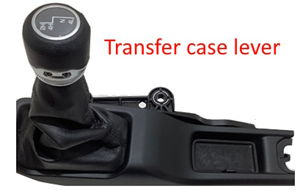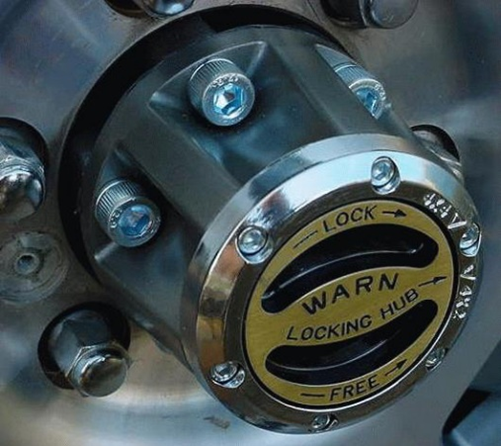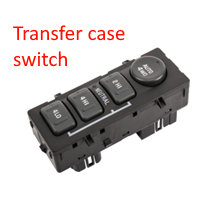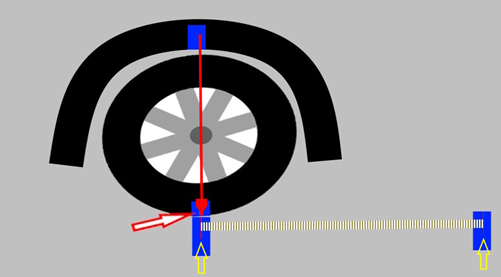In automobiles, a drivetrain is needed to propel the vehicle, otherwise, it
would just be a horse-drawn buggy. Several main components make up the drivetrain, one of
these being the automatic transmission, which is our usual topic of discussion, however,
each of these components affects the driveability and performance of the transmission in
some way. We will discuss the component that distributes power to all the drive wheels.
Tying into the topic of our last article we will cover 4WD systems and how
tire size could affect vehicle operation. But first, we must understand how these systems
work.
Vehicles today use various four-wheel-drive (4WD) and all-wheel-drive (AWD)
systems to enhance traction, particularly in off-road, snowy, or slippery conditions. These
systems are categorized based on their operation, and the level of input from the driver.
Part-Time Four-Wheel Drive (4WD) Systems
Commonly used in trucks and off-road vehicles because of their rugged and
reliable construction. This system is best suited for off-road or low-traction surfaces
because power is distributed equally between the front and rear axles through the transfer
case. This system often offers a selectable two-speed transfer case with high range (direct
ratio) and low range (gear reduction) for a mechanical advantage when certain conditions
demand it.
The drawbacks to this system are:
- They require input from the driver. Usually this is done by moving a shift lever or
electronic switch to lock the transfer case. (Figure 1)
- Some systems require exiting the vehicle to engage locking hubs at the front wheels in
addition to switching the 4WD on. (Figure 2)
- Their rugged construction often comes from using heavier, less efficient rotating
components that increase fuel consumption.
- Equal power distribution when engaged causes binding while turning on dry pavement. This
binding often causes driveline damage if prolonged.

Figure 1 - Transfer case lever

Figure 2 - Locking hub
Full-Time 4WD/All-Wheel Drive (AWD)
Common in crossover SUVs and compact cars, AWD systems are designed
primarily for on-road use and offer enhanced stability in inclement weather or light
off-road situations. It distributes power to all four wheels with minimal driver input.
Power is continuously sent to all four wheels through a viscous or
electronically controlled coupler that allows the front and rear axles to rotate at
different speeds. This enables smoother handling on dry pavement while delivering power to
all drive wheels in slippery conditions.
A variant of full-time AWD is on-demand AWD which operates primarily in
two-wheel drive favoring the front or rear depending on the design. Using speed sensors
along with various other yaw, and g force sensors, the system detects wheel slippage and
sideways vehicle motion, then engages the other drive wheels to distribute power as needed.
Performance-Oriented AWD found in sports cars and high-performance SUVs
offer dynamic handling by varying power distribution between individual wheels, in
conjunction with the braking system, often using torque vectoring technology. This helps the
vehicle turn or straighten itself in all conditions depending on the driver's steering
input.
The drawback to most AWD systems is that they are constructed with small
lightweight components and are not built to withstand heavy towing or offroad rigors
Advanced 4WD Systems
Many modern vehicles incorporate electronic controls that allow automatic
engagement of 4WD based on traction needs. This blends the benefits of both part-time 4WD
and full-time 4WD systems mentioned above. Features like the ability to select 2WD, and
low-range gearing allow the vehicle to climb steep inclines and still conserve fuel when 4WD
is not in use. It also allows the driver to select 4WD auto and allow the vehicle to power
all 4 wheels as needed in low traction situations without binding when turning.
This mode is especially helpful in snowy climates because the system adapts
to road conditions that can change from dry pavement to snow and ice rapidly. See the switch
in fig 3 shows all the options the diver may select with this system to suit their needs
best.

Figure 3 - Transfer case switch
Each system has distinct advantages tailored to specific driving
environments and purposes. Understanding their functionality helps drivers choose the right
vehicle for their needs.
- 4WD is better for rugged terrain and heavy-duty applications, offering driver-selectable
modes and more durability.
- AWD provides seamless operation optimized for varying road conditions and is
user-friendly for everyday driving.
Case study
While working on a 2004 Jeep Grand Cherokee with Quadra-Drive “all-time
4WD" a vibration was observed while driving at highway speed. The vibration felt almost like
a clutch shudder in the transmission, however, the shudder did not go away or change in
nature when disabling transmission lock-up or when selecting other gears.
With this, the vehicle was brought back into the shop and placed on a lift
for inspection. Having prior experience with the system, the fluids were inspected and found
to have a burnt smell but otherwise looked good. Looking at the tire size everything looked
okay. They were all the same size. However, when looking at the tire brand it was different
front to rear and there was a distinct difference in the tread design.
A call was placed to the customer, and they confirmed the two front tires
had been replaced because they were worn and failed inspection, but the rears still had
enough tread to pass so they were not replaced.
A quick rollout measurement found that the tire circumference from front to
rear varied over 1.25”. This was an extreme amount of variance; most AWD systems allow up to
1/4" variance. What happened was the customer, trying to save money, used an off-brand tire
to replace the worn front tires and they were a little taller than the stock OE tires.
Compounding this was that the rear tires were worn making the size
differential even greater. The fix for this was replacing the rear tires with the same size
and brand as the front tires and replacing the transfer case fluid for good measure.
How do we measure roll-out
(circumference)?
You will need:
- 4 Plumb bobs on a string
- Tape measure
- Masking tape
- Sharpie
Start with the vehicle wheels pointed straight, on a flat even surface.
Make sure the surface is long enough to roll the vehicle forward far enough for the tire to
make at least one complete rotation. See figure 5.
For the most accurate results, make sure the
tires air pressure is set to manufacturer specifications
before taking these measurements.

Figure 5
*Note for steps 1-4 the vehicle must remain stationary
1. Place a piece of tape on the floor at the bottom most section of all 4
tires.
2. Place a piece of tape on the outside diameter of each tire.
3. Draw a line on the tape on the floor and the tape on the tire that lines
up with each other.
4. Hang one plumb bob string at each of the 4 wheels with string length so
the plumb bob reaches just above the ground. The string must hang across the wheel center
like in figure 6. Tape may be used to hang the string from the fender and achieve this
alignment.

Figure 6
5. Now, roll the vehicle forward so the tire has completed one full
revolution, and the line marked on the tire lines up with the plumb bob.
6. Place a piece of tape on the floor at each plumb bob and mark where the
plumb bob points.
7. Now Measure between the two marks you made for each tire. This
will give you the distance each tire traveled in one revolution. This measurement is the
circumference of the tire. All four tires should be within ¼” of each other for most AWD/4WD
systems.
An alternative to measuring roll-out would be the use of a tire stagger
gauge. It is slightly less precise, but an acceptable method. It can be done with the
vehicle on a lift and does require as much setup to make the measurement. You are measuring
the diameter of each tire by simply placing the tool over the outside diameter. Now you
compare the readings, looking for a difference higher than ¼” in circumference. The tool
likely comes with markings or a chart to convert diameter into circumference, but if it
doesn’t think back to geometry class (dia. x 3.14 (pi) = Circumference)
Summary
Not all 4WD/AWD systems are created equal or one size fits all, with a
better understanding of how they work we can properly diagnose and distinguish when one is
operating correctly or when it needs servicing. We also stress the importance of properly
sized tires for the driveline to work smoothly, and how to measure them correctly.